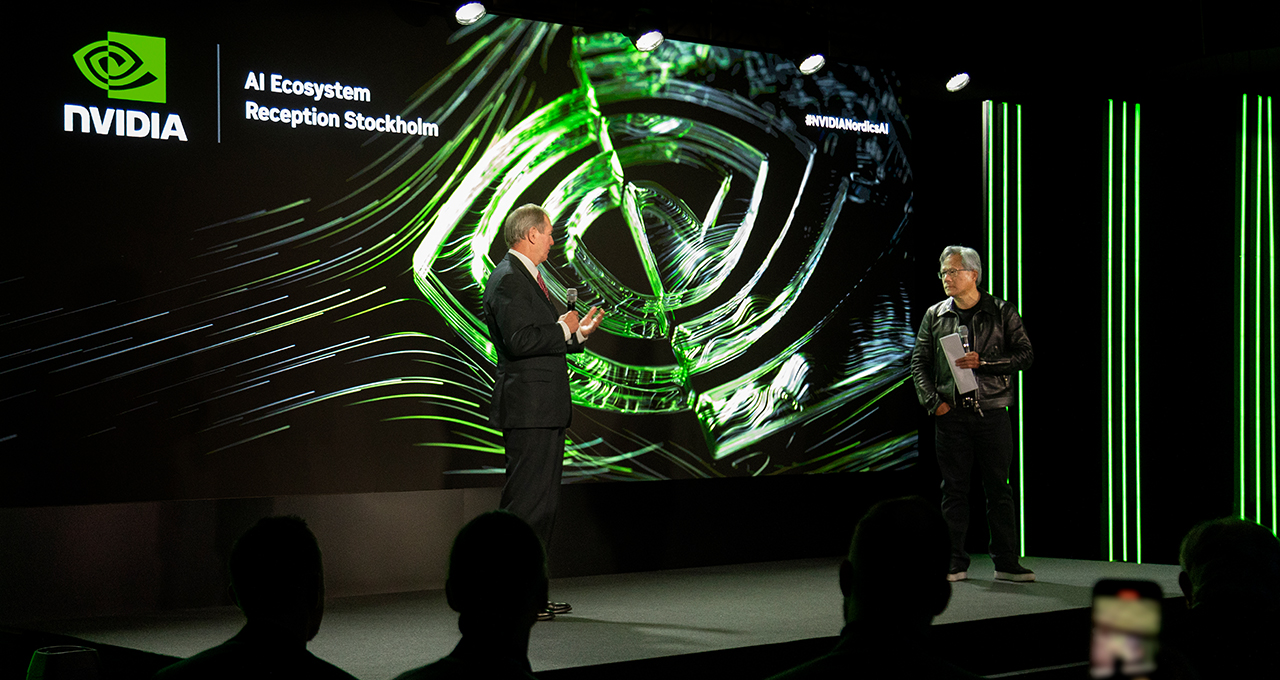More than 600 entrepreneurs, developers, researchers and executives from across the Nordics flocked Tuesday to Stockholm’s sleek Sergel Hub conference center in a further sign of the strength of the region’s AI ecosystem.
The highlight: a far-reaching conversation between NVIDIA founder and CEO Jensen Huang and Swedish industrialist Marcus Wallenberg exploring the intersections of AI, green computing, and Scandinavia’s broader tech scene.
“This generative AI phenomenon is creating a whole slew of new startups, new ideas, new video editing, image editing, new text,” Huang said. “It can achieve capabilities that previous computing platforms cannot.”
The Berzelius supercomputer, named for Jöns Jacob Berzelius, one of the fathers of modern chemistry, has just been upgraded to 94 NVIDIA DGX A100 AI computing systems, delivering nearly half an exaflop of AI performance, placing it among the world’s 100 fastest AI supercomputers.
“Years ago, Marcus and I started talking about a new way of doing computer science. Having a key instrument, like Berzelius, would be a fundamental instrument of future science,” Huang told the audience. “The work that is done on this instrument would make tremendous impacts to life sciences, material sciences, physical sciences and computer science.”
Maximum Efficiency, Minimal Impact
The rising use of electricity is one of the causes of global warming, and powerful, energy-efficient computers are crucial to fighting climate change through green computing.
Huang explained that whether for data centers or the latest smartphone, computer chips, systems and software must be designed and used to maximize energy efficiency and minimize environmental impact.
“Companies large and small have to sign up for the carbon footprint that we use to build the work that we do,” said Huang. “If there’s an opportunity for us to help accelerate workloads and reduce energy use and improve energy efficiency, we will.”
Sweden’s Role in AI
The upgrade comes as AI is powering change in every industry across the globe, with leaders from across the Nordics accelerating the growth of some of the world’s most powerful AI solutions, explained Wallenberg.
“From the perspective of the foundations, we’re trying to work for the betterment of Sweden by promoting the areas of research, technology and medicine,” said Wallenberg, whose family has for generations been deeply involved across the nation’s economy. “We are working together as a team to create possibilities and the foundations for more work to be done.”
The Berzelius system was used for training the first Swedish large language model. Increasing in size 10x every year for the last few years, large language models are just one state-of-the-art AI technology that promises transformation through learned knowledge.
Neural networks trained with massive datasets on powerful systems, LLMs are accelerating discoveries across industries such as healthcare and climate science with software frameworks like NVIDIA BioNeMo. Models like ChatGPT are making a name for themselves as a new way to use AI.
“You can connect models together to retrieve new information so that models like ChatGPT could report on the news today, who won that game, or the latest weather,” Huang said. “The combination of these capabilities means not only the ability to respond and answer questions and write stories, but it can also write programs and solve problems.”
Knowledge From Data
Solving problems requires reliable, physically accurate data. The industrial metaverse, where digital twins of real factories, rail networks or retail stores can be created, is already being used by large companies like Amazon, BMW, Ericsson and Siemens.
Following the conversation between Huang and Wallenberg, Staffan Truvé, CTO and co-founder of cybersecurity company Recorded Future, talked about how data can be used to model intelligence as a digital twin to get an end-to-end view of threats and targets.
“Today, there are three major converging threat areas. Physical, cyber and influence, which is the threat to our brains,” Truvé explained. “By creating an intelligence graph, we’re building a full picture of a threat.”
Digital twins are not the only way to gather valuable insights when developing for the future. Sara Mazur, vice executive director of the Knut and Alice Wallenberg Foundation and chair of the Wallenberg AI Autonomous Systems and Software Program, highlighted the importance of collaboration between academia and industry.
